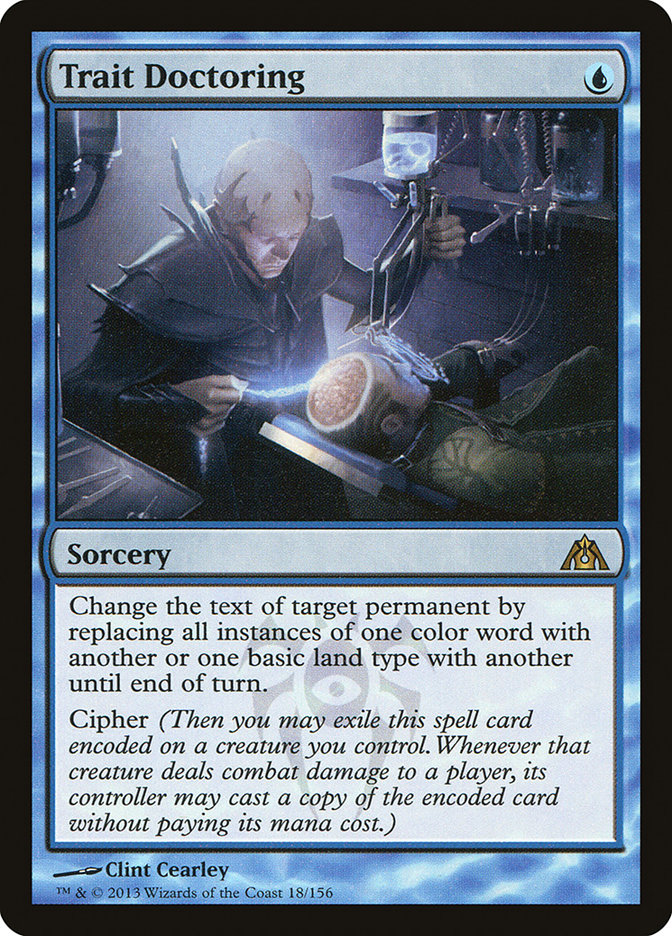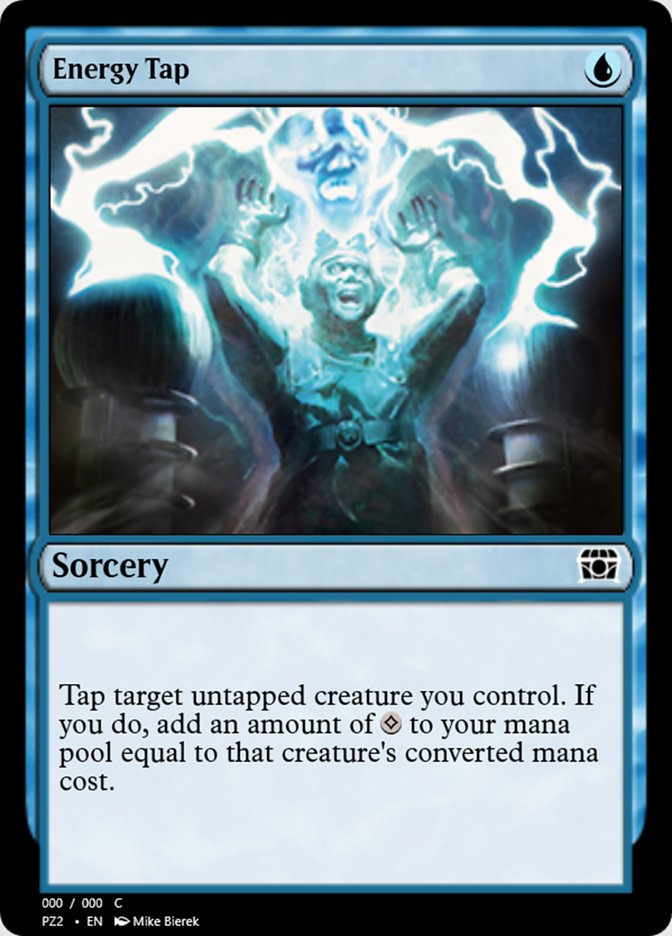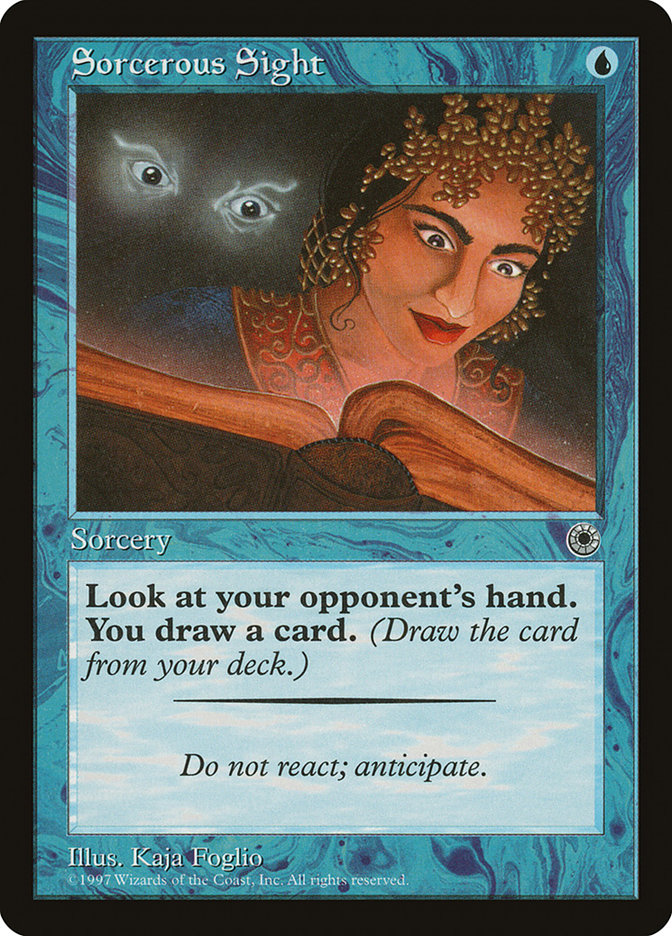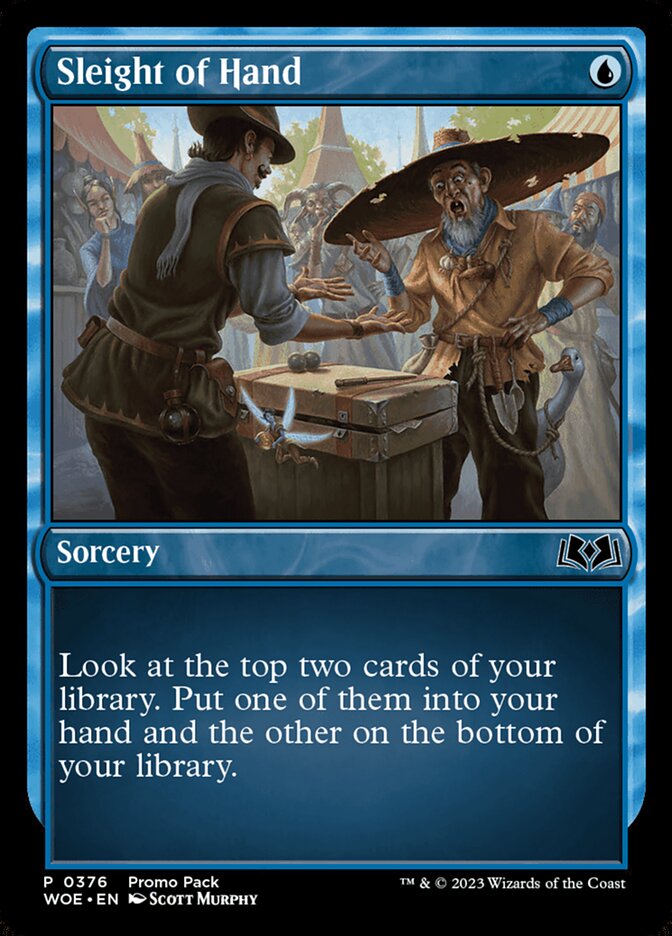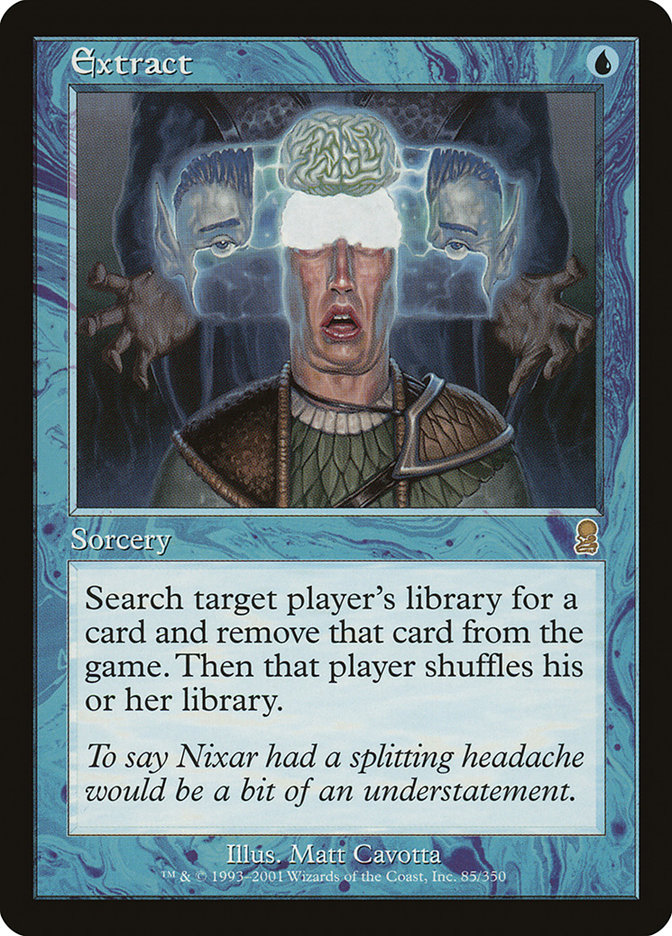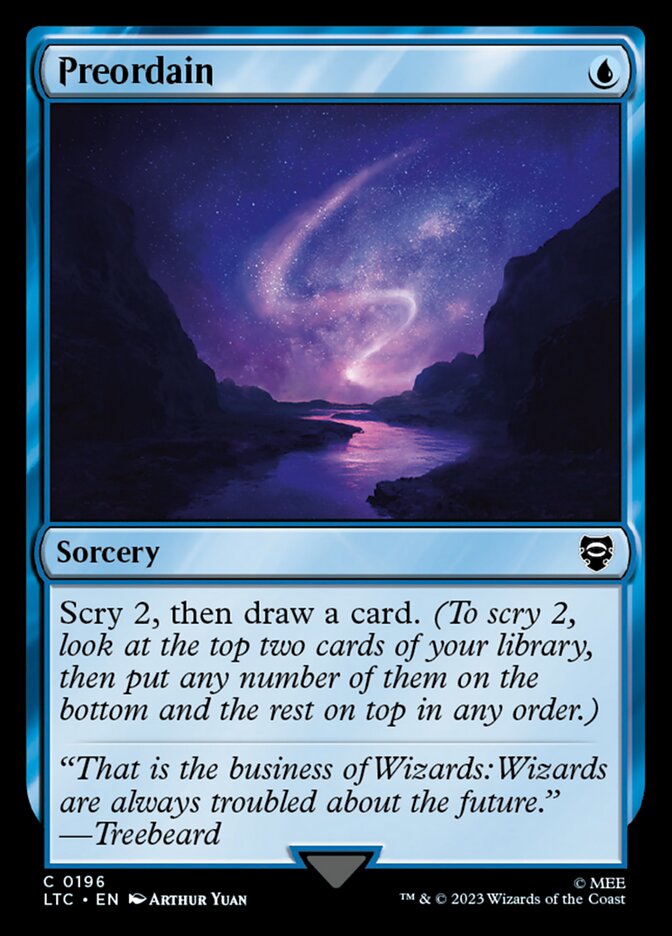Adulteración de rasgos Carta MTG
| El coste de maná | |
| Costo de maná convertido | 1 |
| Rareza | Extraña |
| Tipo | Conjuro |
| Habilidades | Cipher |
| Liberado | 2013-05-03 |
| Coleccione símbolo | |
| Coleccione nombre | Dragon's Maze |
| Coleccione código | DGM |
| Número | 18 |
| Frame | 2003 |
| Disposición | Normal |
| Border | Negra |
| Ilustrado por | Clint Cearley |
Texto de la carta
Cambia el texto del permanente objetivo reemplazando cada mención de un color o un tipo de tierra básica por otro hasta el final del turno. Cifrar. (Luego puedes exiliar esta carta de hechizo, cifrándola en una criatura que controles. Siempre que esa criatura haga daño de combate a un jugador, su controlador puede lanzar una copia de la carta cifrada sin pagar su coste de maná.)
Cartas Similares
Trait Doctoring es una carta única en Magic: The Gathering, destacándose en la categoría de hechizos de modificación de color y tipo. Se parece a cartas como Artificial Evolution, que permite a los jugadores cambiar los tipos de criatura dentro de un hechizo o en un permanente. Mientras que Artificial Evolution tiene el potencial de impactar significativamente en las sinergias tribales, Trait Doctoring ofrece un enfoque más sutil, alterando palabras de color o tipos de tierras básicas por un solo turno.
Otra carta en la conversación es Sleight of Mind, un hechizo más antiguo que modifica los textos en las cartas. Al igual que Trait Doctoring, esto puede ser crucial en ciertos enfrentamientos, especialmente al lidiar con protección contra colores específicos. Sin embargo, Sleight of Mind ofrece un cambio permanente, mientras que los efectos de Trait Doctoring, a pesar de ser fugaces, vienen con el bono adicional de cifrar. Esto significa que se puede codificar en una criatura para lanzarla repetidamente siempre que esa criatura siga infligiendo daño de combate a un jugador.
En resumen, aunque hay otras cartas con habilidades similares, la capacidad de cifrado de Trait Doctoring ofrece una oportunidad única para obtener ventajas estratégicas recurrentes. Esto lo diferencia en el ecosistema de hechizos de personalización de Magic: The Gathering, especialmente para jugadores que pueden capitalizar en su naturaleza repetible.
Cartas similares a Adulteración de rasgos por color, tipo y coste de maná
Aspectos positivos de la carta
Ventaja de cartas: Trait Doctoring puede no permitirte robar cartas directamente, pero facilita la ventaja de cartas a través de su habilidad cifra. Una vez codificado en una criatura, potencialmente puede volver a lanzarse cada vez que esa criatura cause daño de combate a un jugador, permitiéndote seguir alterando los rasgos de permanentes sin gastar cartas adicionales de tu mano.
Aceleración de recursos: Aunque Trait Doctoring no produce recursos adicionales en forma de maná o fichas, acelera tu juego al permitir un uso más eficiente de tus recursos existentes. Al cambiar las palabras de color o tipo de tierra en un permanente, puede ayudar a arreglar tu maná o interrumpir la base de maná de tu oponente, dándote efectivamente una ventaja en recursos.
Velocidad instantánea: Como una instantánea, Trait Doctoring te da la flexibilidad de alterar un permanente a tu conveniencia. Puedes lanzarlo durante tu turno, pero también durante el turno de tu oponente en respuesta a sus acciones, manteniendo tu estrategia adaptable y manteniendo a tu oponente en vilo.
Aspectos negativos de la carta
Requisito de descarte: Los jugadores deben descartar una carta para desatar su efecto, un precio elevado si tu mano ya está menguando o estás planeando estratégicamente para turnos futuros.
Costo de maná específico: Trait Doctoring exige una configuración precisa de maná—tanto azul como un híbrido de azul/negro—presentando un desafío para mazos que se basan en una paleta de colores diversa.
Costo de maná comparativamente alto: El costo inicial puede parecer bajo, pero para su habilidad limitada, compite con otros hechizos que potencialmente podrían ofrecer cambios de juego más impactantes o más versatilidad por la misma cantidad de maná invertida, o incluso menos.
Razones para incluir en tu colección
Versatilidad: La capacidad de Trait Doctoring de cambiar permanentemente un atributo de una carta lo convierte en una herramienta versátil en mazos que explotan vulnerabilidades específicas o fortalezas de colores.
Potencial de combo: Su habilidad cifra le permite ser lanzado repetidamente, ofreciendo una forma consistente de activar desencadenantes o sinergizar con cartas que se benefician de lanzar hechizos.
Relevancia metafísica: En escenarios donde ciertos colores o tipos de cartas dominan, Trait Doctoring puede cambiar sutilmente el curso del juego, potencialmente haciendo que las estrategias de los oponentes sean menos efectivas.
Cómo vencer a Trait Doctoring
Trait Doctoring, si bien no se ve como una carta poderosa en el juego competitivo, tiene usos específicos en el mundo de Magic: The Gathering. Este hechizo azul permite a los jugadores cambiar el texto de una carta reemplazando un color o tipo básico de tierra hasta el final del turno. Sin embargo, si planeas enfrentarte a un mazo que utilice esta carta, hay estrategias a considerar.
Un método efectivo es minimizar el impacto de Trait Doctoring utilizando cartas con texto menos específico en cuanto a color o tipos de tierra, dándole menos objetivos. También puedes contrarrestarlo con hechizos de instantánea como Negar o Dispersar, que son formas de bajo costo para evitar que su efecto ocurra. Alternativamente, centrar tu estrategia en criaturas robustas y hechizos que no dependan de colores específicos o tipos de tierra también puede disminuir la influencia potencial de Trait Doctoring en tu plan de juego.
Centrarse en un estilo de juego resiliente y adaptativo a menudo hará que Trait Doctoring sea menos disruptivo para tu juego. Con la combinación adecuada de hechizos y criaturas versátiles, junto con unos pocos contramaleficios cuidadosamente cronometrados, puedes asegurarte de que Trait Doctoring nunca dicte el rumbo del partido a favor de tu oponente.
Recomendaciones de BurnMana
Explorar las complejidades de Trait Doctoring puede abrir estrategias innovadoras, mejorando tu juego de manera sutil pero poderosa. A medida que ponderas los pros y los contras, recuerda que la verdadera fortaleza de esta carta radica en su habilidad cifra, ofreciendo un valor repetido en las circunstancias adecuadas. Si te intriga la posibilidad de influir en el combate y aprovechar tácticas basadas en el color, Trait Doctoring podría ser la pieza faltante para tu mazo. Aprovecha sus habilidades únicas para obtener una ventaja sobre tus oponentes y perfeccionar tu enfoque en el juego. ¿Curioso por verlo en acción o integrarlo en tus propias estrategias? Sumérgete más profundamente con nosotros y descubre cómo Trait Doctoring puede ser algo más que una carta; puede ser un cambio de juego.
Donde comprar
Si estás buscando comprar una carta MTG Adulteración de rasgos de un coleccione específico como Dragon's Maze, existen varias opciones confiables que debes considerar. Una de las fuentes principales es tu tienda de juegos local, donde a menudo puedes encontrar paquetes de refuerzo, cartas individuales y mazos preconstruidos de colecciones actuales y pasadas. A menudo ofrecen el beneficio adicional de una comunidad donde puedes intercambiar con otros jugadores.
Para un inventario más amplio, particularmente de colecciones más antiguos, mercados en línea como TCGPlayer, Card Kingdom y Card Market ofrecen amplias selecciones y te permiten buscar cartas de colecciones específicos. Las plataformas de comercio electrónico más grandes como eBay y Amazon también tienen listados de varios vendedores, lo que puede ser un buen lugar para buscar productos sellados y hallazgos raros.
Además, el sitio oficial de Magic suele tener un localizador de tiendas y listas de minoristas para encontrar Wizards of the Productos con licencia costera. Recuerde comprobar la autenticidad y el estado de las cartas al comprarlas, especialmente a vendedores individuales en mercados más grandes.
A continuación se muestra una lista de algunos sitios web de tiendas donde puede comprar las Adulteración de rasgos y otras cartas MTG:
 COMPRAR
COMPRAR BurnMana es un socio oficial de TCGPlayer
- eBay
- Card Kingdom
- Card Market
- Star City Games
- CoolStuffInc
- MTG Mint Card
- Hareruya
- Troll and Toad
- ABU Games
- Card Hoarder Magic Online
- MTGO Traders Magic Online
Ver productos MTG
Legalidades
Formatos de Magic the Gathering donde Adulteración de rasgos tiene restricciones
| Formato | Legalidad |
|---|---|
| Commander | Legal |
| Legacy | Legal |
| Modern | Legal |
| Oathbreaker | Legal |
| Vintage | Legal |
| Duel | Legal |
| Pioneer | Legal |
| Penny | Legal |
Reglas e información
La guía de referencia para las reglas de las cartas Adulteración de rasgos de Magic: The Gathering proporciona las reglas oficiales, las erratas emitidas, así como un registro de todas las modificaciones funcionales que se han producido.
| Fecha | Texto |
|---|---|
| 15/04/2013 | Si una criatura con una carta codificada inflige daño de combate a más de un jugador simultáneamente (quizás porque parte del daño de combate fue redirigido), la habilidad desencadenada se activará una vez por cada jugador al que inflige daño de combate. Cada habilidad creará una copia de la carta desterrada y te permitirá lanzarla. |
| 15/04/2013 | Si otro jugador gana el control de la criatura, ese jugador controlará la habilidad desencadenada. Ese jugador creará una copia de la carta codificada y podrá lanzarla. |
| 15/04/2013 | Si se cambia el tipo de tierra básica de una tierra, la habilidad de maná asociada a esa tierra también cambiará, pero su nombre no lo hará. Por ejemplo, si has cambiado "Llanura" por "Isla", una carta llamada Llanura tendrá el tipo de tierra básica Isla y se podrá girar para , y ya no se podrá girar para . |
| 15/04/2013 | Si la criatura abandona el campo de batalla, la carta desterrada ya no estará codificada en ninguna criatura. Permanecerá desterrada. |
| 15/04/2013 | Si el hechizo con cifrado no se resuelve, ninguno de sus efectos ocurrirá, incluyendo el cifrado. La carta irá al cementerio de su dueño y no será codificada en una criatura. |
| 15/04/2013 | Si decides no lanzar la copia, o no puedes lanzarla (quizás porque no hay objetivos legales disponibles), la copia dejará de existir la próxima vez que se realicen acciones basadas en el estado. No tendrás la oportunidad de lanzar la copia en un momento posterior. |
| 15/04/2013 | Si deseas codificar la carta con un cifrado en un permanente no criatura como un Keyrune que puede convertirse en criatura, ese permanente tiene que ser una criatura antes de que la carta con cifrado comience a resolverse. Solo puedes elegir una criatura para codificar la carta. |
| 15/04/2013 | La copia de la carta con cifrado se crea en y se lanza desde el exilio. |
| 15/04/2013 | La carta desterrada con cifra otorga una habilidad desencadenada a la criatura en la que está codificada. Si esa criatura pierde esa habilidad y posteriormente inflige daño de combate a un jugador, la habilidad desencadenada no se activará. Sin embargo, la carta desterrada seguirá estando codificada en esa criatura. |
| 15/04/2013 | El hechizo con cifrado se codifica en la criatura como parte de la resolución de ese hechizo, justo después de los otros efectos del hechizo. Esa carta va directamente desde la pila al exilio. Nunca va al cementerio. |
| 15/04/2013 | El efecto de cambio de tipo puede cambiar parte de una palabra como "negrón" o "caminar por pantanos" si la parte de la palabra se usa para referirse a un color o tipo de tierra básica. |
| 15/04/2013 | Trait Doctoring cambia la palabra de color o tipo de tierra básica cada vez que aparece en la línea de tipo del permanente y/o texto de reglas. No cambia el nombre de la carta ni ninguna instancia de la palabra que se utiliza como parte del nombre de una carta. |
| 15/04/2013 | El efecto de Edición de Rasgos solo cambia el texto impreso en el permanente. No puede cambiar las palabras encontradas en las habilidades que se le han otorgado. Por ejemplo, si has cambiado "verde" por "azul", y el permanente obtiene protección contra el verde (en lugar de tener impresa la protección contra el verde en él), esa habilidad de protección no se ve afectada. El permanente tendrá protección contra el verde. |
| 15/04/2013 | Puedes apuntar a cualquier permanente con Doctorado de Rasgos, incluso a uno sin palabras de color o tipos de tierra básicos en él. |
| 15/04/2013 | Lanzas la copia de la carta con cifra durante la resolución de la habilidad desencadenada. Ignora las restricciones de tiempo basadas en el tipo de carta. |
| 15/04/2013 | Eliges la criatura a medida que la carta se resuelve. La habilidad de cifrado no se dirige a esa criatura, aunque la carta con cifrado puede dirigirse a esa criatura (o a una criatura diferente) debido a sus otras habilidades. |
| 15/04/2013 | Puedes elegir qué palabra estás cambiando y a qué palabra la estás cambiando a medida que se resuelve el Doctorado de Rasgos. |
